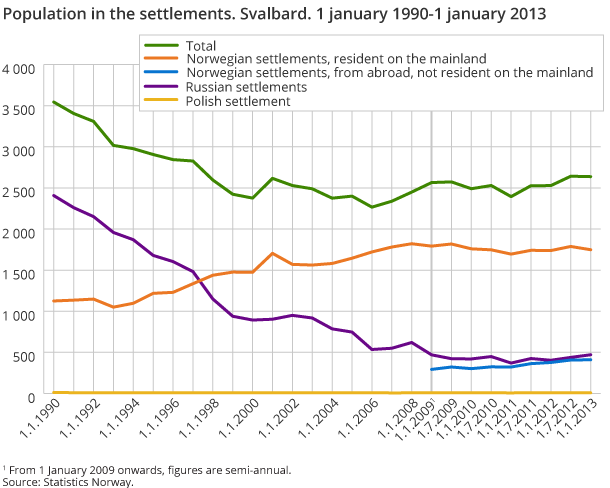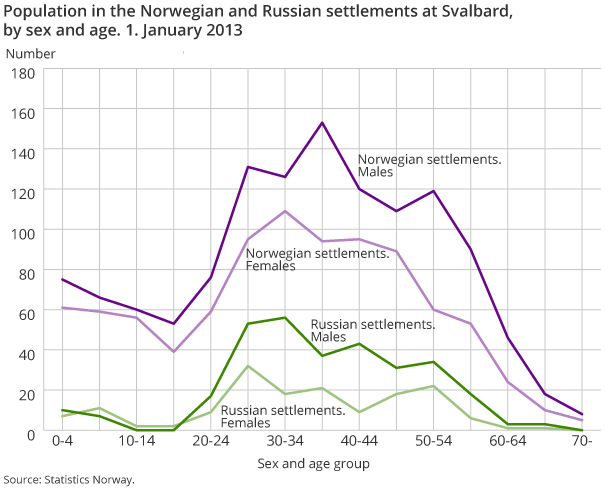Content
Published:
This is an archived release.
Steady population increase at Svalbard
On 1 January 2013, 2 637 persons were registered as living at Svalbard. A total of 2 158 of these lived in the Norwegian settlements, 40 more than one year earlier. In the Russian settlements, the population increased by 70.
| 1st half year 2013 | |||
|---|---|---|---|
| Total | Males | Females | |
| 2 158 | 1 250 | 908 | |
| 0 years | 13 | 9 | 4 |
| 1-5 years | 157 | 81 | 76 |
| 6-12 years | 153 | 79 | 74 |
| 13-15 years | 68 | 42 | 26 |
| 16-19 years | 78 | 43 | 35 |
| 20-44 years | 1 058 | 606 | 452 |
| 45-66 years | 607 | 373 | 234 |
| 67 years or older | 24 | 17 | 7 |
In addition to the 2 158 living in the Norwegian settlements, 471 lived in the Russian settlements. Eight were also living at Hornsund, a permanent research station led by the Polish Academy of Sciences. Even though the population in the Russian settlements has increased by 100 since 1 January 2011, it is a far smaller population than in the early 1990s, when it reached more than 2 000. The number of those living in the Norwegian settlements who are also registered as living on the Norwegian mainland has increased from 1 120 in 1990 to 1 750 at 1 January 2013.
Different sex and age distribution in the Norwegian and Russian settlements
While 60 per cent of the inhabitants in the Norwegian settlements are in the age group 25-54 years, the corresponding share in the Russian settlements is 80 per cent. There is a larger percentage of males (66) in the Russian settlements than in the Norwegian ones (58). The difference is especially noticeable for males aged 25-54, making up 35 per cent of all inhabitants in the Norwegian settlements, but 54 per cent in the Russian ones.
Reproduction as well as migration
In 2012, 23 children were born to parents (mothers) living in the Norwegian settlements at Svalbard. Three persons died, resulting in a birth surplus of 20. A total of 425 moved to Svalbard and 401 moved away, which corresponds to a net in-migration of 24.
Contact
-
Even Høydahl
E-mail: even.hoydahl@ssb.no
tel.: (+47) 95 77 79 06
-
Vilni Verner Holst Bloch
E-mail: vilni.verner.holst.bloch@ssb.no
tel.: (+47) 94 82 25 32
-
Dana Moe
E-mail: dana.moe@ssb.no
tel.: (+47) 99 85 23 42
-
Statistics Norway's Information Centre
E-mail: informasjon@ssb.no
tel.: (+47) 21 09 46 42


